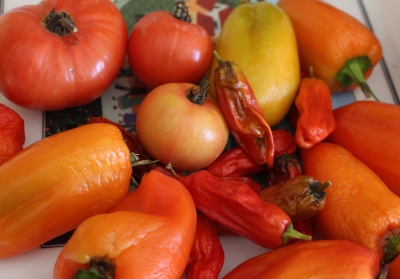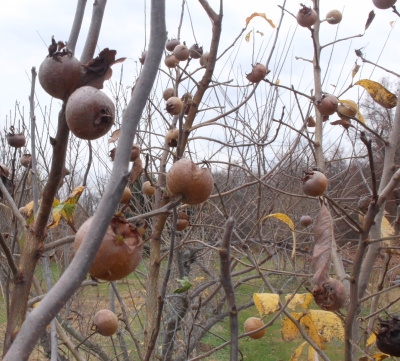IT’S A GAS!
/1 Comment/in Flowers, Fruit, Gardening, Pruning/by Lee ReichLast Tomatoes & Peppers
Late fall, and my thoughts turn naturally to . . . ethylene! You remember ethylene from high school chemistry. A simple hydrocarbon with 2 carbon atoms double-bonded together with 2 hydrogen atoms attached to each of the carbon’s remaining two free bonds. C2H4. It’s a gas, literally, and an important industrial chemical transmuted into such products as polyethylene trash bags, PVC plumbing pipes, and polystyrene packing “peanuts.”
Oh, I forgot, this is supposed to be about plants. Ethylene is synthesized in plants and is a plant hormone with — as is characteristic of hormones — dramatic effects in small amounts.
I think of ethylene as I sliced the last of the season’s fresh garden tomatoes for a sandwich a couple of weeks ago. Note that I wrote “fresh,” not “fresh-picked.” The tomatoes had been picked almost two months prior from vines I was cutting down and gathering up for composting. They sat on a tray in the kitchen, very gradually, over the weeks, morphing in color from light green to pale pink to deep red.
Ethylene is responsible for this transformation from pale and insipid to red and flavorful (flavorful as compared with the pale green or pink stages, not as compared to vine-ripened summer tomatoes). It’s produced naturally in ripening fruits, and its very presence — even at concentrations as low as 0.001 percent — stimulates further ripening.
The tomatoes shared the kitchen tray with peppers, peppers that also were green when laid on the tray. All ripening fruits produce ethylene, peppers included. So let a green pepper sit long enough and — as long as it is sufficiently mature and does not dry out too much, or rot — it will ripen red, or yellow or purple, whatever is its ripe color. Which mine did.
Yes, One Rotten Apple Does . . .
The ethylene given off by a ripe apple or banana can be put to use in speeding up ripening of tomatoes. Just put either of these fruits into the bag with tomatoes. Apples and bananas are climacteric fruits which, instead of emanating a steady stream of ethylene, ramp up production dramatically as full ripeness nears.
Among other effects, ethylene production itself stimulates further ethylene production. So if ripening fruits are left too long in a bag, ethylene stimulates ripening which stimulates more ethylene which stimulates more ripening, ad infinitum, until what is left is a bag of mushy, overripe fruit. Hence, one rotten apple really can spoil the whole barrel.
It’s a Gas for Fruiting Also
Ripening isn’t the only prod to ethylene production in a plant. Stress also can do it, whether from the nibble of an insect, a disease spore wending its way through a plant’s cuticle, wind or snow bending a branch, or pruning shears trimming a wayward branch.
Exogeneous ethylene leaves its mark on more than just promoting ripening. A century and a half ago, pineapple growers in the Azores saw that plants nearer outdoor fires flowered soonest. Plants that flower sooner, fruit sooner.
If you’ve rooted a pineapple crown — relatively easy, just twist it off, plant in pot of well-drained potting soil, and water only when soil dries out — you can speed flowering and fruiting by setting an apple in the crown for a few days, then covering the plant with a bag.
And for Not Staking (Too Much)
Soon, I’ll be going outside, pruning shears in hand, to put ethylene to use again. Ethylene also slows growth, in so doing coaxing flowering.
Pear trees are famous for being slow to settle down to flowering and bearing fruit. No, I’m not planning to hang apples in the pear trees and enclose them in plastic bags! I am planning, after I finish working on the trees with my shears, to bend some well-placed branches to a near horizontal position, using weights, string, and pieces of wire to hold bent branches in place. The stress of bending — compression on one side of a stem, expansion on the opposite side — steps up ethylene production (30-300%), slowing growth, inducing flower bud formation, and shortening the time till I bite into my first pears from young trees. I’m not yet finished with you ethylene. I planted a few new apple trees this year. They need staking, but not too much. Stakes should allow some movement of the developing trunks, and free movement of the top third of the plants. Movement causes the same stresses as branch bending, likewise inducing ethylene production. Ethylene, as you now know, slows growth but also, as you might not know, increases the thickness of the moving part; i.e. makes for a sturdier trunk. That’s what I want for my young trees.
I’m not yet finished with you ethylene. I planted a few new apple trees this year. They need staking, but not too much. Stakes should allow some movement of the developing trunks, and free movement of the top third of the plants. Movement causes the same stresses as branch bending, likewise inducing ethylene production. Ethylene, as you now know, slows growth but also, as you might not know, increases the thickness of the moving part; i.e. makes for a sturdier trunk. That’s what I want for my young trees.
VIRTUAL TRIP TO MEDITERRANEAN
/4 Comments/in Fruit, Gardening, Houseplants, Pruning/by Lee ReichGoodbye to Figs (For Now)
With yellowing leaves and dropping leaves, my greenhouse figs are looking sickly. But all is well in figdom. A common misconception is that figs are tropical trees. They’re not. They’re subtropical, generally tolerating cold down to near 20°F.. And their leaves are deciduous, naturally yellowing and dropping this time of year, just like maples, ashes, and other deciduous trees.
My greenhouse thermostat kicks on when the temperature inside drops to about 35°F. Daytime temperatures depend on sunlight; they might soar to 80° before awakening the exhaust fan on a sunny day in January, or hover around 35°F. on an overcast day that month. All of which is to say that the weather inside my greenhouse matches pretty well that of Barcelona and Rome, with hot dry summers and cool, moist winters. And figs grow very well in those Mediterranean climates. And go dormant.
I harvested my last good fig — from the variety ‘Rabbi Samuel’ — around the middle of this month. Can figophiles enjoy the fruits that late in the season in Barcelona and Rome, I wonder? Many apparently ripe fruits were still hanging from the stems after that date. With cool weather and/or less sunshine from shorter days, the fruits developed an overripe, off flavor. I can’t complain; harvest began in July and I picked enough to periodically have to dry the excess.
Next Year: Go Fig(ure)
I didn’t turn my back on my plants after harvesting my last fig. I jumped right into readying the plants for next year’s harvest.
The first step was hurrying the plants along into dormancy by actually pulling off all remaining leaves.
 Next, pruning. Two of my varieties, Bethlehem Black and Brown Turkey, bear fruit only on new shoots of the current season. Unpruned, new shoots would originate further and further up and out from the trunk — a problem in the limited confines of my greenhouse. Severity of pruning needs to be balanced against when ripening begins. More severe pruning would be more dramatic in its effect, but delays ripening. (Which is why fig trees — their roots, at least — might survive outdoors here under mulch or snow, but when the plant dies back that close to the ground, new sprouts don’t have time to ripen their fruits the following season.)
Next, pruning. Two of my varieties, Bethlehem Black and Brown Turkey, bear fruit only on new shoots of the current season. Unpruned, new shoots would originate further and further up and out from the trunk — a problem in the limited confines of my greenhouse. Severity of pruning needs to be balanced against when ripening begins. More severe pruning would be more dramatic in its effect, but delays ripening. (Which is why fig trees — their roots, at least — might survive outdoors here under mulch or snow, but when the plant dies back that close to the ground, new sprouts don’t have time to ripen their fruits the following season.)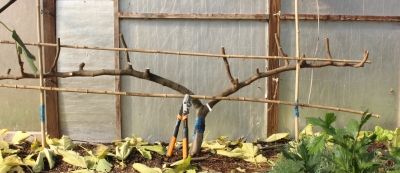
Pruning these trees back to stubs between 3 and 4 feet from the ground keeps them to size and stimulates plenty of new shoots next spring on which fruit ripens from late summer on.
Rabbi Samuel and San Piero fig varieties ripen a July crop on one-year-old stems as well as a second crop, onward from September, on new shoots. So with these varieties, I pruned some stems severely and others enough to leave some year-old wood for the early crop.
Easiest was Rabbi Samuel because it’s trained as an espalier in the form of a T, with a permanent short trunk and two permanent arms emanating in opposite directions from atop the trunk.
Fruiting shoots grow vertically 6 to 12 inches apart from the arms. Today I cut every other fruiting shoot to a stub from which I’ll allow just one new, vertical shoot, for the September crop. I cut each of the other shoots down to about a foot long; they’ll bear the early crop and then, if fruiting stems are crowding each other, can be cut back right after the early harvest. If not crowded, I’ll allow one side shoot to grow on to bear the September crop.
It’s all simpler that it reads, and looks very tidy in the greenhouse now overcrowded with lettuce, celery, arugula, mâche, claytonia, parsley, and Swiss chard. All of which are staples of the Mediterranean vegetable garden in winter.
And More form the Mediterranean
Like figs, citrus also are subtropical plants. Depending on the kind of citrus fruit, they’ll tolerate winter cold into the ‘teens (kumquat) or just below freezing (lime). The plants neither grow as vigorously nor bear as heavily as do figs, so you don’t get much bang for your buck with a potted citrus without choosing carefully what to grow. I grow mine in pots: kumquat, because you can eat the whole fruit, sweet skin and tart flesh, wasting nothing; and, the newest addition to my citrus family (genus, actually), Meyer lemon.
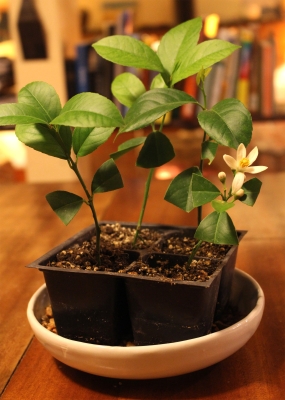 A squeeze of lemon goes a long way in flavoring a salad, livening a cup of tea, and adding pizazz to a cobbler. Growing my own lemons lets me make use also of a rind, for zest, that is free of pesticides.
A squeeze of lemon goes a long way in flavoring a salad, livening a cup of tea, and adding pizazz to a cobbler. Growing my own lemons lets me make use also of a rind, for zest, that is free of pesticides.
Meyer lemon is an orange x lemon hybrid, so is somewhat sweeter than lemon. This variety roots readily from cuttings, so I could have an indoor orchard in short order if I wanted, and bears quickly. A recently-rooted 3-inch-high cutting has already flowered and set a fruit.
Citrus are evergreen and much prettier and more fragrant, when in bloom, than figs. Mine spend winter in sunny windows in a cool room rather than in the greenhouse.
Finally, Chill
A friend recently gave me a lawn chair. My plan is, on sunny winter days, to take my post-prandial siesta on that chair, basking in warm, winter light on the shores of the Mediterranean; that is, in my greenhouse. “…and fair Italia’s sunny shores, where the Mediterranean sea roars…”
THE UGLY, THE TASTY, & THE BEAUTIFUL
/7 Comments/in Design, Fruit/by Lee ReichClose Your Eyes, If Necessary
“A crabby looking, brownish green truncated little spheroid of unsympathetic appearance.” That’s how a British writer of almost 75 years ago described one of my favorite fruits, medlar (Mespilus germanica). True, the fruit is no beauty to some eyes. To me, the fruit has an authentic, old-fashioned, unvarnished look to it, like that of a small, russeted apple whose calyx end (opposite the stem) is flared open.
Medlar is truly an old-fashioned fruit, whose popularity peaked in the Middle Ages. Chaucer mentioned it, indecorously referring to it as “open arse.” Even Shakespeare got his digs in, more discretely call it “open et cetera.”
This past season was a good season for fruits, including medlar. Yesterday, I harvested the crop from the leafless tree. But no, I couldn’t yet sink my teeth into one. Besides its odd appearance, medlar has one more quirk: The fruit needs to be bletted before being eaten. During the bletting process, at cool room temperatures for a couple of weeks, the white, rock-hard interior of the fruit turns to brown mush. A delectable brown mush, much like a very rich applesauce with wine-y overtones.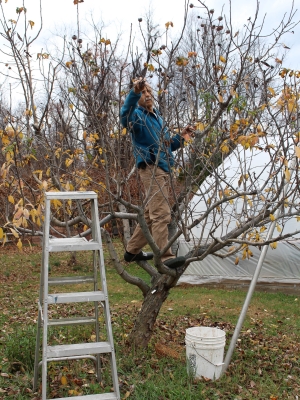 Past writers have also gotten their digs in mocking the required bletting, as if it was akin to rotting. But banana, avocado, and European pears also require post-harvest softening before they are ready to eat. Admittedly, not softening AND browning, which might look like rot, but actually, with medlar, indicates an increase in sweetness and a decrease in acids and tannins. British wine connoisseur George Saintsbury considered medlar the ideal fruit to accompany wine; D. H. Lawrence considered medlars “wineskins of brown morbidity.”
Past writers have also gotten their digs in mocking the required bletting, as if it was akin to rotting. But banana, avocado, and European pears also require post-harvest softening before they are ready to eat. Admittedly, not softening AND browning, which might look like rot, but actually, with medlar, indicates an increase in sweetness and a decrease in acids and tannins. British wine connoisseur George Saintsbury considered medlar the ideal fruit to accompany wine; D. H. Lawrence considered medlars “wineskins of brown morbidity.”
I like the fruit and look forward to drawing out the season by refrigerating portions to delay bletting.
Now Open Your Eyes
Whether or not the fruit is considered ugly and uncouth, the medlar plant has much to recommend it. It’s the perfect multi-use tree for a small yard.
Where space is limited, no need to choose between whether to plant an ornamental or a fruit tree, because medlar is both. The elbowed contortions of the branches, more evident now that the plant has dropped its leaves, lend an air of rusticity. Come spring, white blossoms, each a couple of inches across and every bit as showy as a wild rose, unfold after the plant has pushed out a few inches of growth. A whorl of dark green leaves behind each flower contrasts and frames the blossom.
Each of those blossoms will generally morph into a fruit. No additional tree is needed for pollination — another plus for small yards.
And this is a small tree, so fits well into a small yard. My tree, in rich soil and over ten years old, is only about eight feet high and wide.
(For more on the history, cultivation, and varieties of medlar, see the chapter on this fruit in my book Uncommon Fruits for Every Garden).
More Eye Candy
As I walked back to my medlar tree, harvest basket in hand, other fruit plants, my blueberry bushes, caught my attention, these solely for their beauty. Blueberries offer some kind of “eye candy” in every season, with sprays of urn-shaped, white flowers in spring and slightly bluish, green leaves that look spry all season long.
Autumn is blueberry’s showiest season, when the leaves usually come alive with a crimson color that rivals that of burning bush, a shrub grown solely for its autumn show. This month, the blueberry bushes look finer than they ever have, with some of each bush sporting golden yellow leaves, some orange leaves, and some crimson leaves.
I’m going to attribute this year’s blueberry spectacular to the weather. Leaves’ crimson color is due to anthocyanins, which need sugars to develop. Warm, sunny days foster photosynthesis and sugar production but the relatively warm night’s of this season burn up those sugars. Carotenoids are responsible for the oranges and yellows of leaves. They’re always present, and my theory is that, with warm nights, less anthocyanin was present to mask them.
Even after leaf drop, blueberries have something to offer, visually, when cold weather turns the stems red (perhaps less this year because of less anthocyanins?). This winter, I’ll enjoy whatever the plants have to offer, along with last season’s berries, now in the freezer.

